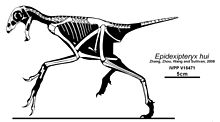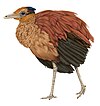耀龙属
| 耀龙属 化石时期:卡洛维阶,
| |
|---|---|

| |
| 在日本展出的正模标本 | |
| 科学分类 | |
| 界: | 动物界 Animalia |
| 门: | 脊索动物门 Chordata |
| 纲: | 蜥形纲 Sauropsida |
| 总目: | 恐龙总目 Dinosauria |
| 目: | 蜥臀目 Saurischia |
| 亚目: | 兽脚亚目 Theropoda |
| 科: | †擅攀鸟龙科 Scansoriopterygidae |
| 属: | †耀龙属 Epidexipteryx Zhang et al., 2008 |
| 模式种 | |
| †胡氏耀龙 Epidexipteryx hui Zhang et al., 2008
| |
耀龙属(属名:Epidexipteryx)是小型近鸟类恐龙的一属,化石在中国内蒙古宁城县的道虎沟组发现。[1]耀龙代表了化石记录中已知最早的装饰性羽毛。[2]
在不计现代鸟类的状况下,耀龙是已知体型最小的兽脚亚目恐龙;但在考虑现代鸟类的状况下,吸蜜蜂鸟等部分鸟类的体型比耀龙来得小。
发现

耀龙化石发现于2006年,模式种是胡氏耀龙(E. hui),由周忠和、张福成等人命名;属名意为“炫耀的羽毛”,种名则是以2008年4月逝世的中国古哺乳动物学家胡耀明为名。[3]正模标本编号为IVPP V 15471,现保存于北京古脊椎动物与古人类研究所。[1]
由于出版前的一个错误,[4]耀龙的叙述手稿于2008年9月下旬在预印本门户网站首次出现。这篇论文正式发表在2008年10月23日出版的《自然》杂志上。[1]
叙述

耀龙所知于一个保存完好的部分骨骼,其中包括四根由中心羽轴及羽片组成的细长尾羽。然而,与现代鸟类的舵羽(尾羽)不同的是这些羽片并未分叉成单独的细丝,而是由单一的带状薄片组成。耀龙具有一层较简单的体羽,由平行羽枝构成,类似原始的有羽毛恐龙。然而,耀龙的部分身体羽毛基部似乎形成自膜相结构(Membranous structure)[1],有人认为这可能是羽毛进化的一个阶段。[5]
耀龙骨骼长25厘米(10英寸),若加上尾巴的羽毛,其身长可达44.5公分,接近鸽子的大小,[6]作者估计其重量为164克,小于多数原始鸟翼类。[1]

耀龙的头骨在许多特征上也是独一无二的,与会鸟、窃蛋龙类和镰刀龙类大致相似。耀龙的牙齿只长在颌部前端,异常长的前牙向前倾斜,在其它兽脚类中仅有恶龙具有这一特征。骨骼其余部分类似于近亲擅攀鸟龙,尤其是在其它恐龙中不常见的髋部结构:耻骨短于坐骨,而后者则向顶端扩张。耀龙的尾巴末端具有不寻常的椎骨,类似现代鸟类和一些窃蛋龙类的尾综骨。[1]
分类
耀龙在近鸟类中的确切系统发育位置尚不确定。作者对其进行系统发育分析,发现它是擅攀鸟龙科的一个成员,也是鸟翼类的一个原始成员;[1]Hu等人(2009)随后进行的分析证实了这一点。[7]阿格诺林和诺瓦斯(2011)随后进行的分析证实了它是一种擅攀鸟龙科,但将该科置于一个不同系统发育位置:将其与阿瓦拉慈龙科和演化支真手盗龙类在多分支中恢复(包含鸟翼类和恐爪龙类)。[8]特纳、马克维奇和诺瑞尔(2012)的初步系统发育分析中包括耀龙,但将擅攀鸟龙/树息龙排除在外,因为仅有后一分类单元所知于成年标本;作者担心将擅攀鸟龙/树息龙包含在初步分析中存在问题,因为前者仅所知于幼年标本,而幼年标本“不一定保留准确定位一个分类单元所需的所有成体特征”(特纳、马克维奇&诺瑞尔,2012年,第89页)。耀龙被恢复为基础近鸟类,不属于真手盗龙类。作者确实注意到其系统发育位置不稳定;与最节俭的解决方案相比,限制耀龙作为基础鸟翼类需要两个额外步骤,而限制它作为窃蛋龙类的原始成员只需要一个额外步骤。


一个单独的探索性分析将擅攀鸟龙/树息龙包括在内,并发现它是鸟翼类的原始成员;作者注意到它与耀龙位于不同演化支中,后者处于真手盗龙类之外。限制擅攀鸟龙科的单系性需要四个额外步骤并将耀龙移到鸟翼类中。[9]迦德弗利兹等人(2013)恢复了单系群擅攀鸟龙科;作者发现,该科是近鸟类的原始成员,也是一个包含鸟翼类和恐爪龙类的演化支的旁系群。[10]阿格诺林和诺瓦斯(2013)也发现了这一单系群,但却认为它们属于非近鸟类的手盗龙类,是窃蛋龙类的旁系群。[11]
以下是Zhang等人2008年演化树的简略版本。
| 手盗龙类 Maniraptora |
| |||||||||||||||||||||||||||||||||||||||
古生物学
古生态学
参考资料
- ^ 1.0 1.1 1.2 1.3 1.4 1.5 1.6 1.7 1.8 Zhang, F.; Zhou, Z.; Xu, X.; Wang, X.; Sullivan, C. A bizarre Jurassic maniraptoran from China with elongate ribbon-like feathers (PDF). Nature. October 2008, 455 (7216): 1105–1108 [2015-05-24]. PMID 18948955. doi:10.1038/nature07447. (原始内容 (PDF)存档于2015-05-24).
- ^ Morgan, James. New feathered dinosaur discovered. BBC. 2008-10-22 [2009-07-02]. (原始内容存档于2009-09-29).
- ^ Chinese scientists discovers new dinosaur species. People's Daily Online. October 27, 2008 [November 4, 2008]. (原始内容存档于February 2, 2009).
- ^ Dr. Thomas Holtz, Jr. "The mistaken scansoripterygid". Message to the Dinosaur Mailing List <http://dml.cmnh.org/2008Oct/msg00008.html (页面存档备份,存于互联网档案馆)> (October 1, 2008)
- ^ Archived copy. [2010-12-10]. (原始内容存档于2011-06-06).
- ^ Zhang, F.; Zhou, Z.; Xu, X.; Wang, X.; Sullivan, C. "A bizarre Jurassic maniraptoran from China with elongate ribbon-like feathers", Supplementary Information. Nature. 2008, 455: 1105–8. PMID 18948955. doi:10.1038/nature07447.
- ^ Dongyu Hu; Lianhai Hou; Lijun Zhang; Xing Xu. A pre-Archaeopteryx troodontid theropod from China with long feathers on the metatarsus. Nature. 2009, 461 (7264): 640–643. PMID 19794491. doi:10.1038/nature08322.
- ^ Agnolín, Federico L.; Novas, Fernando E. Unenlagiid theropods: are they members of the Dromaeosauridae (Theropoda, Maniraptora)?. Anais da Academia Brasileira de Ciências. 2011, 83 (1): 117–162. PMID 21437379. doi:10.1590/S0001-37652011000100008.
- ^ Alan Hamilton Turner; Peter J. Makovicky; Mark Norell. A review of dromaeosaurid systematics and paravian phylogeny. Bulletin of the American Museum of Natural History. 2012, 371: 1–206. doi:10.1206/748.1. hdl:2246/6352.
- ^ Pascal Godefroit; Helena Demuynck; Gareth Dyke; Dongyu Hu; François Escuillié & Philippe Claeys. Reduced plumage and flight ability of a new Jurassic paravian theropod from China. Nature Communications. 2013, 4: Article number 1394. PMID 23340434. doi:10.1038/ncomms2389.
- ^ Federico L. Agnolín; Fernando E. Novas. Avian ancestors. A review of the phylogenetic relationships of the theropods Unenlagiidae, Microraptoria, Anchiornis and Scansoriopterygidae. SpringerBriefs in Earth System Sciences. 2013: 1–96. ISBN 978-94-007-5636-6. doi:10.1007/978-94-007-5637-3.
- ^ Cau, A (2012), Il ritorno del paraviano pterosauro-mimo? (页面存档备份,存于互联网档案馆), Theropoda, July 2012
外部链接
| ||||||||||||||||||||||||||||||||||||||||||||||||||||||||||||||||||||||||||||||||||||||||||||||||||||||||||||||||||||||||||||||||||||||||||||||||||||||||||||||||||||||||||||||||||||||||||||||||||||||||||||||||||||||||||||||||||||||||||||||||||||||||||||||||||||||||||||||||||||||||||||||||||||||||||||||||||||||||||||||||||||||||||||||||||||||||||||||||||||||||||||||||||||||||||||||||||||||||||||||||||||||||||||||||||||||||||||||||||||||||||||||||||||||||||||||||||||||||||||||||||||||||||||||||||||||||||||||||||||||||||||||||||||||||||||||||||||||||||||||||||||||||||||||||||||||||
|
Text is available under the CC BY-SA 4.0 license; additional terms may apply.
Images, videos and audio are available under their respective licenses.























